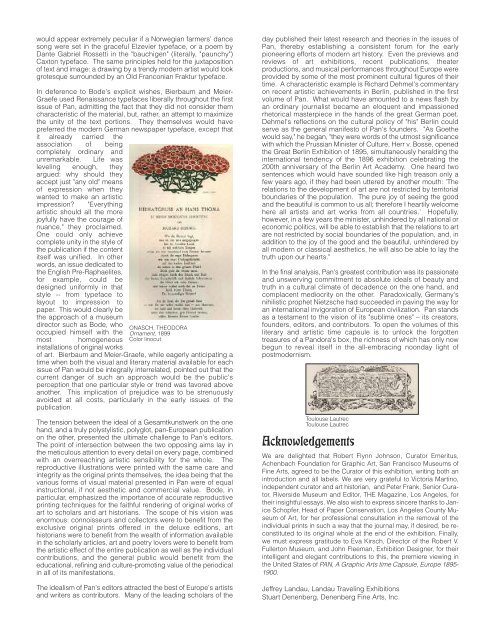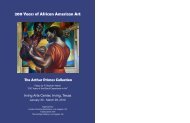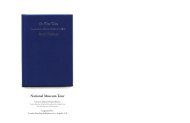PAN PAN - Landau Traveling Exhibitions
PAN PAN - Landau Traveling Exhibitions
PAN PAN - Landau Traveling Exhibitions
- No tags were found...
You also want an ePaper? Increase the reach of your titles
YUMPU automatically turns print PDFs into web optimized ePapers that Google loves.
would appear extremely peculiar if a Norwegian farmers' dance<br />
song were set in the graceful Elzevier typeface, or a poem by<br />
Dante Gabriel Rossetti in the "bauchigen" (literally, "paunchy")<br />
Caxton typeface. The same principles held for the juxtaposition<br />
of text and image: a drawing by a trendy modern artist would look<br />
grotesque surrounded by an Old Franconian Fraktur typeface.<br />
In deference to Bode's explicit wishes, Bierbaum and Meier-<br />
Graefe used Renaissance typefaces liberally throughout the first<br />
issue of Pan, admitting the fact that they did not consider them<br />
characteristic of the material, but, rather, an attempt to maximize<br />
the unity of the text portions. They themselves would have<br />
preferred the modern German newspaper typeface, except that<br />
it already carried the<br />
association of being<br />
completely ordinary and<br />
unremarkable. Life was<br />
leveling enough, they<br />
argued: why should they<br />
accept just "any old" means<br />
of expression when they<br />
wanted to make an artistic<br />
impression "Everything<br />
artistic should all the more<br />
joyfully have the courage of<br />
nuance," they proclaimed.<br />
One could only achieve<br />
complete unity in the style of<br />
the publication if the content<br />
itself was unified. In other<br />
words, an issue dedicated to<br />
the English Pre-Raphaelites,<br />
for example, could be<br />
designed uniformly in that<br />
style -- from typeface to<br />
layout to impression to<br />
paper. This would clearly be<br />
the approach of a museum<br />
director such as Bode, who<br />
occupied himself with the<br />
ONASCH, THEODORA<br />
Ornament, 1899<br />
Color linocut<br />
most homogeneous<br />
installations of original works<br />
of art. Bierbaum and Meier-Graefe, while eagerly anticipating a<br />
time when both the visual and literary material available for each<br />
issue of Pan would be integrally interrelated, pointed out that the<br />
current danger of such an approach would be the public's<br />
perception that one particular style or trend was favored above<br />
another. This implication of prejudice was to be strenuously<br />
avoided at all costs, particularly in the early issues of the<br />
publication.<br />
The tension between the ideal of a Gesamtkunstwerk on the one<br />
hand, and a truly polystylistic, polyglot, pan-European publication<br />
on the other, presented the ultimate challenge to Pan's editors.<br />
The point of intersection between the two opposing aims lay in<br />
the meticulous attention to every detail on every page, combined<br />
with an overreaching artistic sensibility for the whole. The<br />
reproductive illustrations were printed with the same care and<br />
integrity as the original prints themselves, the idea being that the<br />
various forms of visual material presented in Pan were of equal<br />
instructional, if not aesthetic and commercial value. Bode, in<br />
particular, emphasized the importance of accurate reproductive<br />
printing techniques for the faithful rendering of original works of<br />
art to scholars and art historians. The scope of his vision was<br />
enormous: connoisseurs and collectors were to benefit from the<br />
exclusive original prints offered in the deluxe editions, art<br />
historians were to benefit from the wealth of information available<br />
in the scholarly articles, art and poetry lovers were to benefit from<br />
the artistic effect of the entire publication as well as the individual<br />
contributions, and the general public would benefit from the<br />
educational, refining and culture-promoting value of the periodical<br />
in all of its manifestations.<br />
The idealism of Pan's editors attracted the best of Europe's artists<br />
and writers as contributors. Many of the leading scholars of the<br />
day published their latest research and theories in the issues of<br />
Pan, thereby establishing a consistent forum for the early<br />
pioneering efforts of modern art history. Even the previews and<br />
reviews of art exhibitions, recent publications, theater<br />
productions, and musical performances throughout Europe were<br />
provided by some of the most prominent cultural figures of their<br />
time. A characteristic example is Richard Dehmel's commentary<br />
on recent artistic achievements in Berlin, published in the first<br />
volume of Pan. What would have amounted to a news flash by<br />
an ordinary journalist became an eloquent and impassioned<br />
rhetorical masterpiece in the hands of the great German poet.<br />
Dehmel's reflections on the cultural policy of "his" Berlin could<br />
serve as the general manifesto of Pan's founders. "As Goethe<br />
would say," he began, "they were words of the utmost significance<br />
with which the Prussian Minister of Culture, Herr v. Bosse, opened<br />
the Great Berlin Exhibition of 1895, simultaneously heralding the<br />
international tendency of the 1896 exhibition celebrating the<br />
200th anniversary of the Berlin Art Academy. One heard two<br />
sentences which would have sounded like high treason only a<br />
few years ago, if they had been uttered by another mouth: 'The<br />
relations to the development of art are not restricted by territorial<br />
boundaries of the population. The pure joy of seeing the good<br />
and the beautiful is common to us all; therefore I heartily welcome<br />
here all artists and art works from all countries.' Hopefully,<br />
however, in a few years the minister, unhindered by all national or<br />
economic politics, will be able to establish that the relations to art<br />
are not restricted by social boundaries of the population, and, in<br />
addition to the joy of the good and the beautiful, unhindered by<br />
all modern or classical aesthetics, he will also be able to lay the<br />
truth upon our hearts."<br />
In the final analysis, Pan's greatest contribution was its passionate<br />
and unswerving commitment to absolute ideals of beauty and<br />
truth in a cultural climate of decadence on the one hand, and<br />
complacent mediocrity on the other. Paradoxically, Germany's<br />
nihilistic prophet Nietzsche had succeeded in paving the way for<br />
an international invigoration of European civilization. Pan stands<br />
as a testament to the vision of its "sublime ones" – its creators,<br />
founders, editors, and contributors. To open the volumes of this<br />
literary and artistic time capsule is to unlock the forgotten<br />
treasures of a Pandora's box, the richness of which has only now<br />
begun to reveal itself in the all-embracing noonday light of<br />
postmodernism.<br />
Toulouse Lautrec<br />
Toulouse Lautrec<br />
Acknowledgements<br />
We are delighted that Robert Flynn Johnson, Curator Emeritus,<br />
Achenbach Foundation for Graphic Art, San Francisco Museums of<br />
Fine Arts, agreed to be the Curator of this exhibition, writing both an<br />
introduction and all labels. We are very grateful to Victoria Martino,<br />
independent curator and art historian, and Peter Frank, Senior Curator,<br />
Riverside Museum and Editor, THE Magazine, Los Angeles, for<br />
their insightful essays. We also wish to express sincere thanks to Janice<br />
Schopfer, Head of Paper Conservation, Los Angeles County Museum<br />
of Art, for her professional consultation in the removal of the<br />
individual prints in such a way that the journal may, if desired, be reconstituted<br />
to its original whole at the end of the exhibition. Finally,<br />
we must express gratitude to Eva Kirsch, Director of the Robert V.<br />
Fullerton Museum, and John Fleeman, Exhibition Designer, for their<br />
intelligent and elegant contributions to this, the premiere viewing in<br />
the United States of <strong>PAN</strong>, A Graphic Arts time Capsule, Europe 1895-<br />
1900.<br />
Jeffrey <strong>Landau</strong>, <strong>Landau</strong> <strong>Traveling</strong> <strong>Exhibitions</strong><br />
Stuart Denenberg, Denenberg Fine Arts, Inc.




